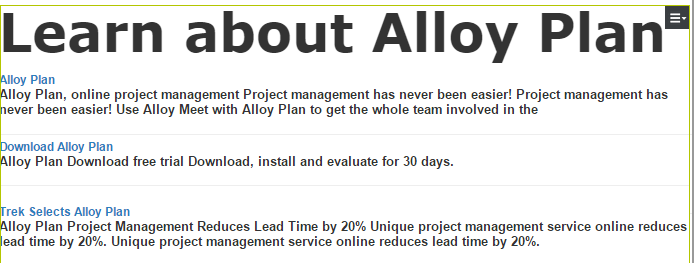 Customized search block
Customized search block
You have access to the customized search block functionality if an administrator enabled the feature.
A customized search block Shared, reusable content, such as an image banner, a page listing, or a video, that you can insert into one or more pages. If you edit a block's content, it updates every page on which it was inserted. (See Assets.) displays content from your website based on your search criteria. For example, you want to display content found using the search term alloy plan.
You can modify a block's appearance by including a heading, descriptions, and setting the number of results. When you place a customized search block on a page, the results of your criteria appear, as shown in the following image.

To create a customized search block, use the following steps after the block is created. You can edit it from the On-page editing view Where you can edit selected properties for content in a WYSIWYG-like view. (See All properties editing view for comparison.) (basic settings only) or the All properties editing view Where you access and edit all properties for content. (See On-page editing view for comparison.) (all settings).
- Create a block, as explained in Blocks, using the Customized Search block type.
- Under Required Properties, enter the Search phrase One or more words that a user enters into a search box to begin a search.. You must enter at least one character. This phrase reappears on the block's properties screen, from where it can be edited.
- Click Create. The display options screen appears.
- Access the All properties editing view.
- Under the Content tab, enter search criteria. Only Search phrase is required. Use the remaining fields to filter the search and control the display of results. The block displays content that satisfies all criteria.
- Search heading. If you want a heading to appear above search results, enter its text.
- Basic Search settings
- Search phrase. Enter text for which you want to search content. You must enter at least one character.
- Match all words. Select to require the search to include all text; clear to search for any word in the search phrase.
- Number of hits. Enter the number (1-1000) of search results that appear in the block.
- Include description. Select to display the description of each search result.
- Advanced search settings
- Search root. By default, all content is searched. To filter the search, select a content root; only content within and under the root is searched. For example, you want to search only content in the
/campaignsfolder, or its child folders. - Content types. By default, all content types CMS content types: folders, pages, blocks, and, assets (media files). Commerce: CMS content types plus catalogs. are searched. To filter the search, select content types to include. For example, you want to only search pages whose type is Landing Page.
- Include Best Bets. Use synonyms. If desired, use the Best Bets and Synonyms features to enhance the search results. See Promoting content using best bets and Adding synonyms for similar phrases.
Example: Real Madrid press releases
Your website provides news about the Union of European Football Associations (UEFA). You want to display the five most recent press releases about Real Madrid. So, you
- Create a customized search block.
- Use Real Madrid as the Search phrase.
-
Assume your site has a page tree node News, whose content uses two page types: News for ordinary news, and Press releases.
- Use the Search root field to select the News page tree node.
- Use the Content types field to select the Press release page type.
- Set Number of hits to 5.
- Place the block in appropriate locations on your site.
Additional resources
- Customized search block styling guide (for developers)
- Customized Search Block in Episerver Find (for developers)